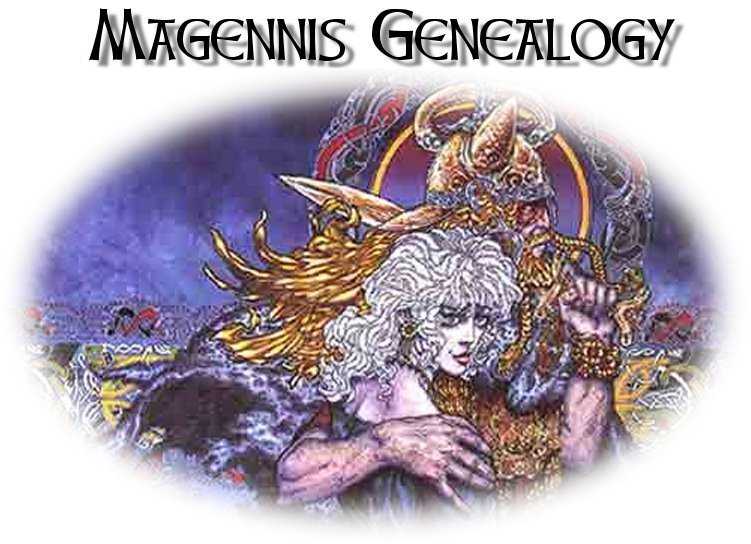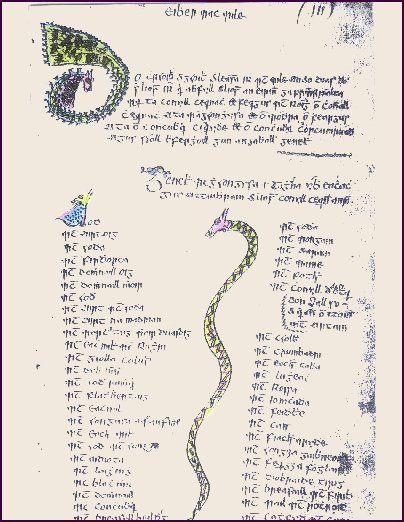
 My research into the genealogy and history of the Magennises is ongoing. To date
I have
managed to find the graves of my great-grandparents, William and Elizabeth McGuinness, who
are buried in
Newtown cemetery at Trim, County
Meath, and whose headstone is inscribed in the Irish language. My own branch
of the family has its origins in county Meath, and the reasons for this, as far as I am aware,
are as follows: It appears
that in the year 1690, one of my
ancestors left the Magennis territory of Iveagh in County Down,
and travelled southward to Oldbridge,
in County Meath, to fight on the side of
the Catholic king
James against his Protestant nephew William of Orange at the Battle of the
Boyne. For one reason or another, following
the battle, he did not return to the ancient patrimony of the Mournes, but settled somewhere in the area, and
there are still quite a
few McGuinnesses to be found there today.
Another as
yet unnamed ancestor is said
to have been killed at the battle of Tara in 1798, during the
United Irish Rebellion of 1798
against English rule.
My research into the genealogy and history of the Magennises is ongoing. To date
I have
managed to find the graves of my great-grandparents, William and Elizabeth McGuinness, who
are buried in
Newtown cemetery at Trim, County
Meath, and whose headstone is inscribed in the Irish language. My own branch
of the family has its origins in county Meath, and the reasons for this, as far as I am aware,
are as follows: It appears
that in the year 1690, one of my
ancestors left the Magennis territory of Iveagh in County Down,
and travelled southward to Oldbridge,
in County Meath, to fight on the side of
the Catholic king
James against his Protestant nephew William of Orange at the Battle of the
Boyne. For one reason or another, following
the battle, he did not return to the ancient patrimony of the Mournes, but settled somewhere in the area, and
there are still quite a
few McGuinnesses to be found there today.
Another as
yet unnamed ancestor is said
to have been killed at the battle of Tara in 1798, during the
United Irish Rebellion of 1798
against English rule.
 The history of my family is a great personal interest of mine,and I am
constantly trying to find out more regarding my ancestors as time and the
availability of relevant documents allows. In 1996 I had the privilege of meeting a
young lady by the name of Maria del Mar Servet-Magenis, a direct
descendant of one of the Magennis chieftains who left Ireland during what is called "The Flight of the Earls"
in the early 17th century, when many heads of the old Gaelic families chose military service with
the kingdoms of various
European countries, rather than remain in Ireland having been dispossessed by the English of much of their land.
As you can see, the original spelling of Maria's name has changed somewhat
with the passage of time, being possessed of just one "n", and it also includes her matriarchal
family name, which is the custom in Spain. She had come to Ireland with a friend of hers to
visit the same sites in County Down which I had seen just a year before. She told
me that there is a small graveyard close to where she lives which contains only
the remains of Magennises. To realise that we were distant relatives,
separated by time and geography, yet members of the same
illustrious clan whose ancestors may have migrated across the wide ocean to Ireland from Spain in the remote
past, was truly fascinating.
The history of my family is a great personal interest of mine,and I am
constantly trying to find out more regarding my ancestors as time and the
availability of relevant documents allows. In 1996 I had the privilege of meeting a
young lady by the name of Maria del Mar Servet-Magenis, a direct
descendant of one of the Magennis chieftains who left Ireland during what is called "The Flight of the Earls"
in the early 17th century, when many heads of the old Gaelic families chose military service with
the kingdoms of various
European countries, rather than remain in Ireland having been dispossessed by the English of much of their land.
As you can see, the original spelling of Maria's name has changed somewhat
with the passage of time, being possessed of just one "n", and it also includes her matriarchal
family name, which is the custom in Spain. She had come to Ireland with a friend of hers to
visit the same sites in County Down which I had seen just a year before. She told
me that there is a small graveyard close to where she lives which contains only
the remains of Magennises. To realise that we were distant relatives,
separated by time and geography, yet members of the same
illustrious clan whose ancestors may have migrated across the wide ocean to Ireland from Spain in the remote
past, was truly fascinating.
 With our meeting, it seems as if Magennis history has, in a sense, completed a long and
circuitous journey, from the time the
Milesians
, the Celts of Spain, first gazed from their lofty tower of Breoghan, at
Carunna, (the modern-day city of La Coruña, in Galicia) towards the
distant horizon to the north, and dreamed of a time when they would set out in
search of the fabled island of Inisfáil...The Isle of Destiny...The Ireland in
which I live today.
With our meeting, it seems as if Magennis history has, in a sense, completed a long and
circuitous journey, from the time the
Milesians
, the Celts of Spain, first gazed from their lofty tower of Breoghan, at
Carunna, (the modern-day city of La Coruña, in Galicia) towards the
distant horizon to the north, and dreamed of a time when they would set out in
search of the fabled island of Inisfáil...The Isle of Destiny...The Ireland in
which I live today.

 The document below is a page from the 12th-century "Leabhar Laighin", or Book of Leinster, detailing the genealogy
of the clan Magennis (Mac Aonghusa) and tracing its descent back to Conall Cearnach , chief of the
Knights of the Red Branch, at Eamhain Macha, the ancient capital of Ulster, in the first century A.D.
The caption at the head of the page is
written in an archaic dialect of the Irish language, unknown
to many modern-day students, as I found out while trying to have it deciphered. It was eventually translated into English by
a native Irish speaker from the Aran Islands, a Mr. Fitzgerald, for whose assistance I remain most grateful.
The text reads as follows:
The document below is a page from the 12th-century "Leabhar Laighin", or Book of Leinster, detailing the genealogy
of the clan Magennis (Mac Aonghusa) and tracing its descent back to Conall Cearnach , chief of the
Knights of the Red Branch, at Eamhain Macha, the ancient capital of Ulster, in the first century A.D.
The caption at the head of the page is
written in an archaic dialect of the Irish language, unknown
to many modern-day students, as I found out while trying to have it deciphered. It was eventually translated into English by
a native Irish speaker from the Aran Islands, a Mr. Fitzgerald, for whose assistance I remain most grateful.
The text reads as follows:
"Here are set out the genealogies of the descendants of Ir Mac Mile.
Two descendants of Ir principally have descendants in Ireland;
That is, Conall Cearnach and Féargus Mac Róigh.
From Conall Cearnach are descended Mac Aonghusa (Mc Guinness)
and Ó'Mórdha (O'More or Moore). From Féargus are descended
Ó'Connchúbhair (O'Connor) of Ciarraí (County Kerry)
and Ó'Connchúbhair of Corcomroe, and the descendants of Ferghal
and all their genealogical branches.
The genealogy of Mac Aonghusa, lords of Uíbh Eachach (Iveagh),
down to whom we will give here the descendants of Conall Cearnach:"
Aodh (Hugh)
Mac Airt Óig (Son of Art the Younger)
Mac Aodh (Son of Hugh)
Mac Firdorcha (Son of the Dark Men)
Mac Dómhnaill Óig (Son of Donal the Younger)
etc., etc.
|
![]()




![]()
![]()
![]()

